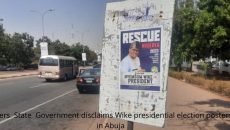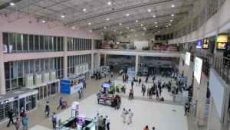Thirty-five years after it became Nigeria’s capital, the Federal Capital Territory Administration has not only maintained but improved on the original vision, mission and mandate of the founding fathers
Abuja’s Cinderella story began on August 9, 1975 when the military government of late General Murtala Ramat Muhammed decided to give Nigeria a new befitting capital. Lagos, the former Federal Capital, could no longer serve the dual purpose of both a state and the federal capital due to congestion and population explosion. Specifically, the official reasons are: poor topography lying almost below sea level which makes it subject to flooding and ocean surge; limited land mass for development; traffic congestion; inadequate housing; environmental pollution; relative insecurity as a result of its vulnerability to attacks; obscure or peripheral location which meant that many Nigerians had to travel long distances to reach their capital. Again, Lagos belongs to a particular ethnic group which, according to them, made it difficult for the city to be truly national or neutral. In addition, Lagos was under too much pressure being an entry-point for international trade as well as state and federal capital. The vision was to build a new capital city that would be a centre of unity as well as accessible and acceptable to all.
The government set up an eight-man panel headed by Akinola Aguda, a legal luminary and one-time chief justice of the Republic of Botswana, to examine the problem of Lagos and proffer acceptable solutions. Other members of the panel were: Tai Solarin; O. K. Ogan, a professor; Monsignor Pedro Martins, a colonel; Owen Flebal, a chief; Mohammed Ismail Bashir; Ajato Gandan, a professor; and E. E. Nsefik, a chief who served as the secretary. After their extensive tour of 30 possible locations across the country, the panel submitted its report in December 1975. The report declared Lagos unfit as the nation’s capital being the commercial and industrial hub of the country.
Consequently, the Aguda Panel recommended a vast virgin territory in the middle of Nigeria to replace Lagos as the capital of the country. The whole of this ‘vast territory’ was named Abuja, after one of the numerous villages that were later displaced to create the new capital. Abuja, like Jerusalem, is surrounded by a range of rocky hills and an alluring landscape enhanced by a natural drainage to numerous natural rivers, rivulets and a big natural lake.
Based on the recommendation, on February 5, 1976 the military government of late Muhammed created the new Federal Capital Territory via Decree No. 6. Tragically, Muhammed was assassinated eight days later in a coup d’état. But the dream did not die with him. The decree vested the responsibility of the development of Abuja with the Federal Capital Development Authority, FCDA. In June 1977, FCDA engaged International Planning Associates, IPA, from the United States to prepare a draft master plan for Abuja and its environs. It took IPA a year and a half to produce a 286 master plan.
According to the design, which provided for a phased development, Abuja was divided into sectors, districts and neighbourhoods and each sector would have a population of between 100,000 and 250,000. Put together, Abuja was supposed to have a population of 1.6 million after the completion of Phase I and 3.1 million after the completion of Phase II. Today only Phase I is completed but the population is about 3.5 million. About 1.96 per cent of the Federal Capital City, FCC, was set aside for government use; 3.49 per cent for auxiliary services; and 48.97 per cent for residential development; 3.61 for light industries; 7.22 per cent for infrastructure; 2.2 per cent for commercial use; and 32.50 per cent for green areas and recreational facilities. Kenzo Tange, a Japanese architect, planned and designed the Central Business District, filling the gaps left by the master plan.
The master plan set 1986 for the first occupation of Abuja. That year Nigeria hosted ECOWAS Conference in Abuja and this quickened the pace of work. The successful hosting of the ECOWAS conference quickened the relocation of government from Lagos to Abuja. In 1987, ECOWAS relocated its secretariat to Abuja. And in 1991, the African Union summit was successfully hosted in Abuja. A few days after the conference on December 12, 1991, federal government finally relocated to Abuja. General Gado Nasko, then FCT Minister, handed the then military president, General Ibrahim Babangida, key to the city at the City Gate. It symbolised the handover of the city to the landlord, for indeed the President is the governor of FCT. This power he entrusts to the FCT Minister to exercise on his behalf.
Since 1976, Abuja has had 15 administrators as follows: Ajose Mobolaji Adeogun (1976–1979); John Jatau Kadiya (1979–1982); Abubakar Iro Danmusa (1982–1983); Haliru Dantoro (Oct. 1983–Dec. 1983); Major Gen. Mamman Jiya Vatsa (1984–1985); AVM Hamza Abdullahi (1986–1989); Major Gen. Mohammadu Gado Nasko (1989–1993); Lt. Gen. Jeremiah T. Useni, (1993–1998); Maj. Gen. Mamman Tsofo Kontagora (1998–1999); Architect Ibrahim Baba Bunu (1999–2001); Engineer Muhammed Abba-Gana (2001–2003); Mallam Nasir Ahmed el-Rufa’i, (2003-2007); Dr. Aliyu Modibbo Umar (2007–2008); Senator Muhammad Adamu Aliero (December 2008–April 2010). The present Minister, Senator Bala A. Mohammed, was appointed on April 6, 2010.
When he assumed office it was not easy because of what he met on ground. “I was confronted by several cogs in the wheel of governance which included chaotic and corrupt land administration, abuse of mass housing programme, endemic traffic congestion, failing environmental orderliness, threatening security situation, poor and inadequate transportation services, inaccessible and poor education standard, overstretched and inadequate health facilities, poor revenue collection as well as leakages, over-lapping and duplication of departmental responsibilities,” he recalled.
These were enough to frighten an average man but Mohammed was not Mr Average. To overcome these challenges, what did he do? “We adopted the following as our vision and mission in order to make positive impact on the lives of the residents of the Federal Capital Territory: A first class Capital Territory with effective service delivery comparable to the best in the World.” Likewise, he adopted the mission: “To build and administer the Federal Capital Territory in strict compliance with the master plan through the establishment of an effective and enduring service oriented administration that can respond to the needs of all residents and other stakeholders.”
Mohammed did not stop at formulating a vision and mission; he formulated a road map for sustainable development for the territory. How did he do this? “We decided to get a team of wise men to give us a blueprint that will assist in moving the Federal Capital Territory to the next level.” He set up a 17-member committee to chart a road map for the sustainable development of the Federal Capital Territory. With the recommendations of this committee, the Federal Capital Territory Administration, FCTA, under Mohammed went to work. This organised approach laid the foundation for the great successes he has achieved toady in FCT.
Follow Us on Social Media



 WhatsApp us
WhatsApp us